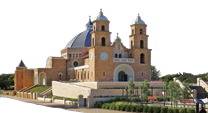I was struck by Fr Greg OKellys reflection in his Port Pirie diocesan magazine The Witness of August 2011 and have asked his permission to reprint it. I invite you to read (below) and reflect on his words.
He speaks of the growing division for many between Church and life. While many of us connect and integrate faith, and life as in weekend church and living during the week, many do not.
While in our homes so much Christian love is expressed and lived, I think we need to ask how much nowadays is being done to express our faith as families by praying together.
Also we have grown up with religious symbols in our homes. This is less evident nowadays in many homes. Carl Jung said If people lose their symbols their culture will die. We can likewise say that without our religious symbols our faith will be affected and run the risk of dying.
Faith and life the two fit together so well and enrich each other. Faith, as we know, offers so much to our understanding of life and its practical living. I thank Bishop OKelly for his thought provoking article.
In regard to Faith I wish to announce something special for the whole of our Church in Australia. A Year of Grace is being planned and will begin Pentecost 2012 and conclude the following Pentecost. Fr Michael Morrissey has readily agreed to coordinate this in our Diocese. Its aim is to focus on Christ and our personal Faith in Him, which in turn affects everything else. It will not be a new programme but will be a time to focus more on Contemplating the Face of Christ, as Pope John Paul II often said.
Finally as you read this I will be in Rome for the Australian Bishops Ad Limina. It is a time to report on our diocese to the Pope and to the central offices called Dicastries. It is also a time (and I really like this) as a body of Australian Bishops in union, with our Holy Father and the foundation stones of St Peter and St Paul, to strengthen our Faith in Jesus.
Please keep praying for us the Australian Bishops so that we may grow in Faith and help lead the people of God in Australia to the best of our ability in the forthcoming Year of Grace.
Bishop O'Kelly's Article "Should the Bishop Close the Churches?
It might seem a startling move, that the Bishop close all fifty-seven churches in our diocese! Why such a suggestion, one asks. Perhaps it might be an effective way to bring about family Church, of reviving the family as the community in which the faith is communicated, taught, practiced and nourished?
Very much of the shape of Australian Catholicism was moulded in Ireland. A giant of the Irish Church was Cardinal Paul Cullen, Archbishop of Dublin and Primate of Ireland from 1852 1878. He was the first Irish Cardinal, and greatly committed to the Vatican and the Papacy. His indirect influence on the Australian Church was profound. Cardinal Patrick Moran was his nephew, and the twelve Irish priests made Bishops in Australia during Cullens time were all his pupils and some were his relatives, all at a time when the character of Australian Catholicism was being shaped.
One of the great contributions of Cardinal Cullen was the devotional revolution (as it is termed) that he initiated in Ireland, serving a Church that was coming out of the penal era, when Catholic churches were not allowed to be built, Catholic schools were forbidden, and there was a general discrimination against Catholics in British-run Ireland. Working with the new religious orders that were being founded then (the Sisters of Mercy, Christian Brothers and so on) changes were introduced among the Catholics of Ireland, through the many devotions that were promoted.
Among the many fruits of this devotional revolution were multiplicity of vocations to the religious life, resulting in so many Sisters and Brothers coming to mission countries like Australia, and also at home the churches became crowded with more than ninety percent of the population attending weekly Mass.
What was the situation like beforehand? In the days of strong discrimination against the Church under British rule, the priests had little option but to move from house to house to say Mass, and neighbours and people from the village would crowd in. The home became the principal place for the handing on of the faith. The life of the Church took place in the home. The Church became freer and the role of the parish church as the Mass centre grew, a balance was maintained between home and church for religious practice. For a century there was a very good balance, with the church the place for the Mass and the celebration of the Sacraments, and the home for the nurturing of the faith.
It was our experience also in Australia where the home was the place where for most families the religious devotions like night prayers, the rosary, grace before meals, the sprig of palm from Palm Sunday, images of the Sacred Heart, Our Lady and some of the Saints, holy water, and so on, were practiced. The home was the context for the faith, reinforced by the school, and celebrated in the church.
There has been a change. In many of our homes there are no images of Mary and the Saints, no crucifix, no grace said, no prayers together as a family, not a Bible or missal readily to hand. We go to church if we want religious practice. The home is neutral. Clearly, I am painting a picture with very broad strokes, just to make a point. In our homes there is of course a massive example of Christian love and comfort through parents and child, but nevertheless little is done to express our faith as families in acts of prayer together. There is little done of worship in many homes. Our only religious experience takes place when we go into a church building. In many homes there is no religious experience, such as some prayer or reading of Scripture together, had in a home.
Look, however, at the faith of the Jewish people enduring through centuries of persecution, against massive acts of annihilation of whole communities. But their faith has survived, and it is a family-based faith. The mother lights the candle in the home on the Friday evening and intones the psalms and the prayers. A family faced, table-top liturgy, springing from the home. They go to the synagogue on the Sabbath, but the dynamism comes from the acts of worship in the home. On the other hand, we have grown to act as if religious experience only takes place in a church, not in our homes. If we can rediscover how to be a family based church, it will stop a hardening of attitudes. We are in danger of moving towards seeing our homes as the places for real living, and the church for the place of religious practice, a divorce that will over time enfeeble faith, allow Christ not to be mentioned or celebrated where we live our real lives, in our homes.
Hence, if our churches were closed, and we had to go back to Masses in the homes as the only place to worship, would this, I ask with tongue in cheek, help revive our faith and worship, and help reduce the drift of our young away from their religious practice? If prayer or Scripture is not practiced in the home, and our young people are not going to a church, then they are necessarily living lives where there is no hearing of the Word, no opportunity to be still and know that I am God, no developing of a maturing faith. There will be much input from other sources music and media, texting and involvement in sport or fashion, but no input from the Gospel of Jesus to help mould their inner lives of faith, hope and love. Bishop Greg OKelly SJ


